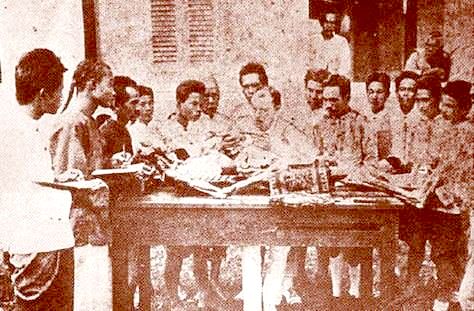The First Surgical Operation in Siam
Surgical operations were unheard of in Siam until American physician and missionary Dr. Dan Beach Bradley (aka Moh (= doctor) Budlay) arrived in Bangkok in July, 1835 (more on page 25).
The following month, on August 27, he performed surgery – without the benefit of anesthetic – on the forehead of a Chinese laborer with a benign tumor.
The operation was a success and Bradley received admiring applause. The surgeon was henceforth known as “the very smart doctor from America”.
On January 13, 1837, a cannon exploded at a temple fair at Wat Prayoon sited by the banks of the Chao Praya River on Thonburi side, killing eight people and injuring many more. One of the wounded was sent to Bradley, who amputated his right arm at the shoulder. Later that year, he spent almost an entire day extracting a man's molar.
(The monument erected to commemorate the event)
In his book “Siam Then”, Bradley recalls that one of his first medical tasks after arriving in Bangkok was treating slaves of the King who were sick with cholera, smallpox and other diseases caused by unhealthy living conditions. The doctor complained that he could do little in the long term because the royal court ignored his pleas to improve the slaves’ lot.
He later opened a small clinic in his house and within a few months had treated some 3,500 patients, ranging in age from 10 to 100. Bradley recorded in his journal 180 illnesses among the Siamese, with skin problems the most prevalent, followed by eye ailments, especially cataracts.
Bradley's reputation as a great doctor spread across the country. On November 10th, 1836, a Buddhist monk from Sukhothai brought his brother, who had been blinded by infection and five other monks suffering from cataracts to see the doctor. He performed operations on all of them.
In treating the cataracts, it is believed that Bradley employed a cutting-edge method for the time, “extracapsular extraction”, which had just been invented by French ophthalmologist Dr. Daviel.
Bradley wrote that his medical fees were fruit and food. His single largest payment took the form of 45 buckets of rice from Chaophraya (noble rank given by the king) Polathep, another of the many cataract sufferers who was fortunate enough to meet the good Dr. Bradley.

Results 1 to 25 of 1906
Thread: Memory Lane (In my own language)
Threaded View
-
22-03-2021, 02:52 PM #11
Last edited by nathanielnong; 22-03-2021 at 03:11 PM.
Thread Information
Users Browsing this Thread
There are currently 32 users browsing this thread. (0 members and 32 guests)












 Reply With Quote
Reply With Quote